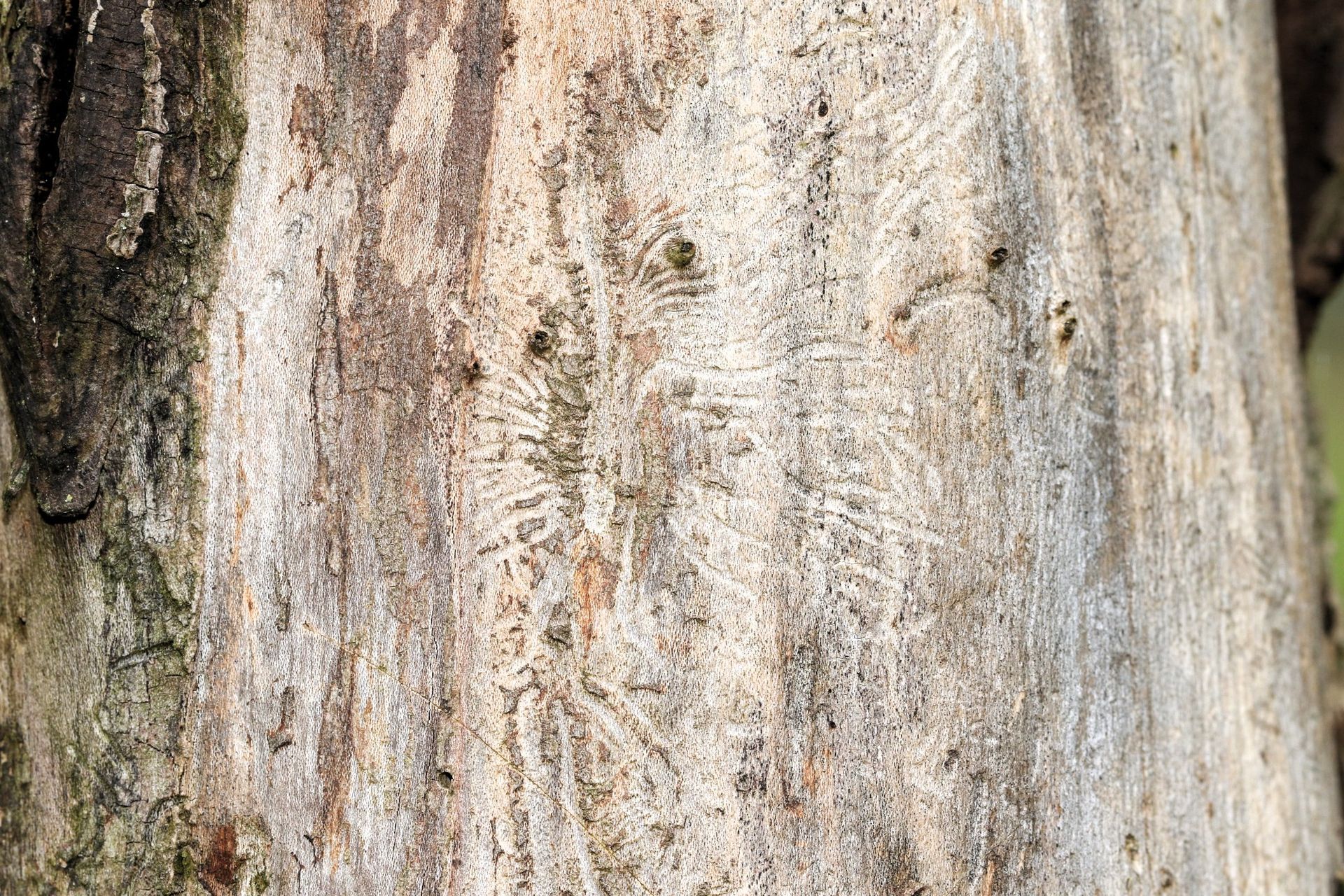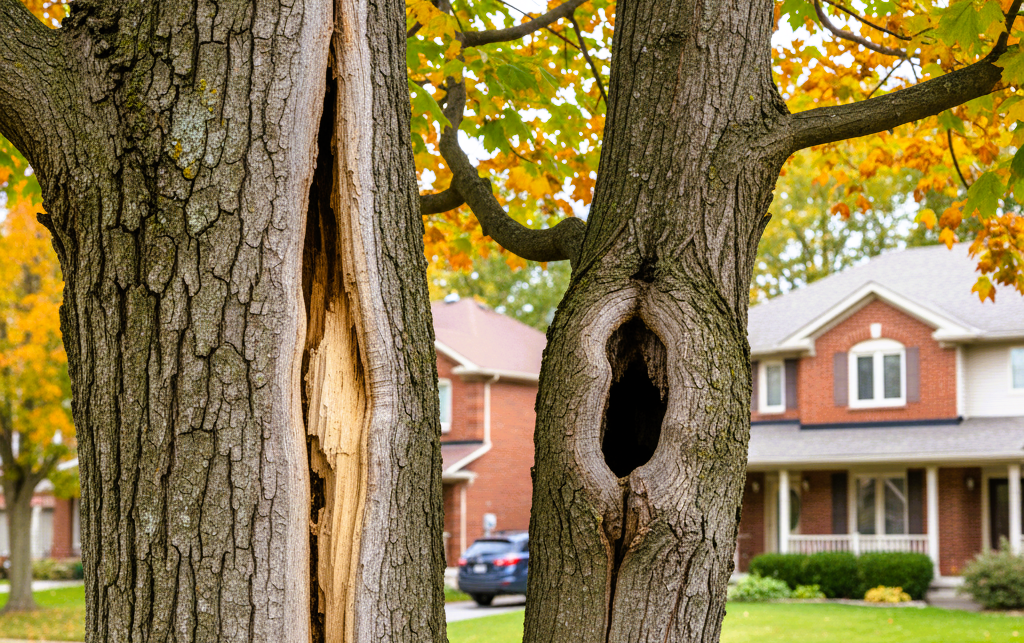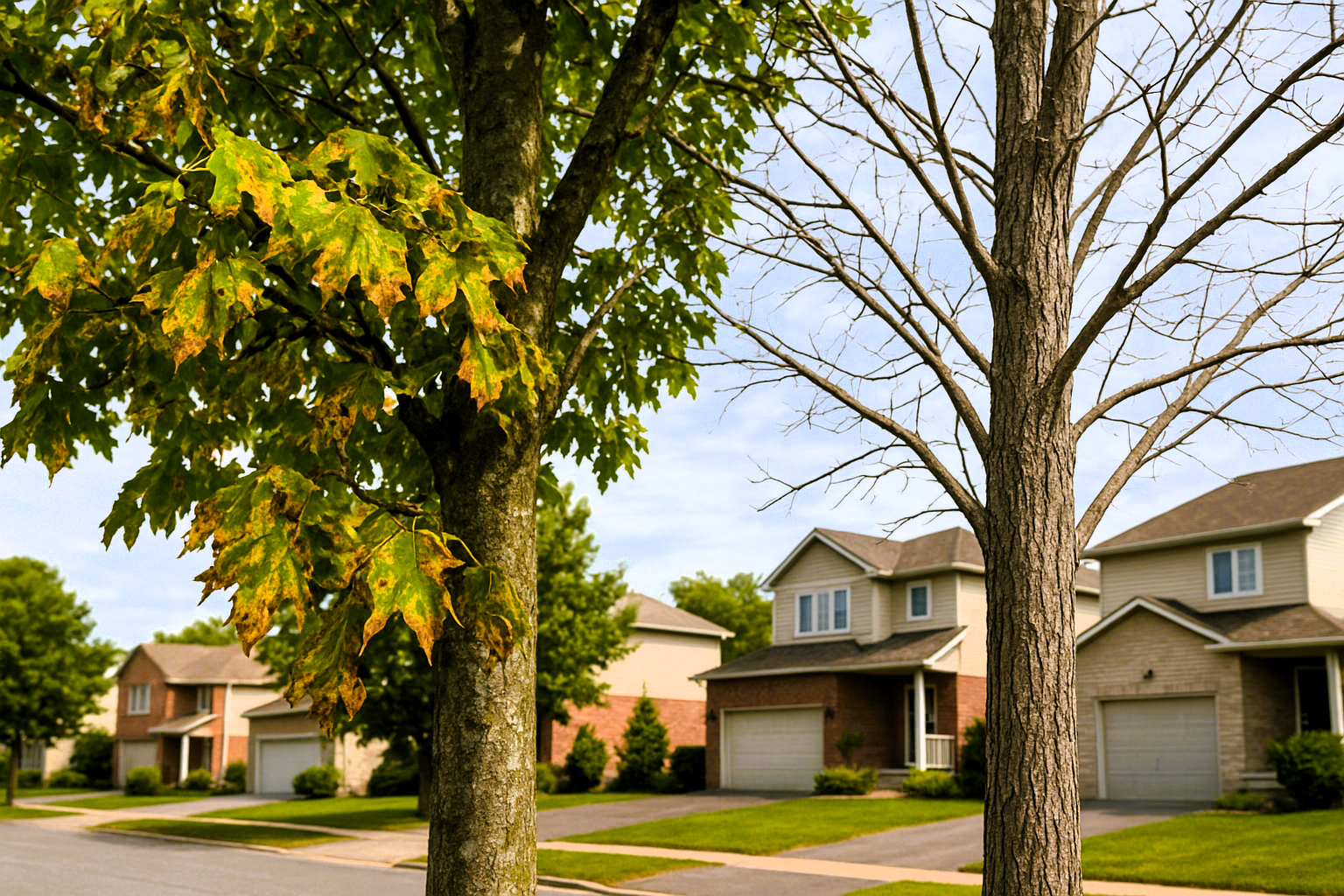Common Tree Diseases and How to Spot Them Early
Early detection tips to protect Kanata’s trees from costly damage

Got mature trees in your yard in Kanata? Lucky you. They add beauty, shade, and serious curb appeal. But here’s the catch — trees can get sick, just like us. And if you don’t catch those signs early, things can go downhill fast (and get expensive).
Whether you own a home, manage a property, or just love your leafy companions, this guide will help you recognize the most common tree diseases in the Kanata area — and how to deal with them before they cause real damage.
1. Maple Tar Spot
What it looks like:
Those black polka dots on your maple leaves? That’s tar spot — a harmless-looking fungus that’s more annoying than dangerous.
Early signs:
- Yellow spots that slowly darken
- Round, black blotches that look like tar
- Leaves dropping sooner than they should
How serious is it?
Not too bad. It won’t kill the tree, but repeated infections can stress it out. Just rake and dispose of infected leaves in the fall — don’t toss them in your compost pile.
2. Beech Bark Disease
What’s going on:
It starts with tiny bugs burrowing into the bark, then a fungus moves in. The result? Nasty cankers and potential tree death if left untreated.
What to watch for:
- White, fuzzy patches on the bark
- Reddish sap oozing from cracks
- Dead limbs or thinning leaves up top
Why it matters:
This one spreads quickly. The earlier you catch it, the better your shot at saving the tree.
3. Dutch Elm Disease
The lowdown:
It’s a notorious fungal disease spread by elm bark beetles. It’s already wiped out thousands of elms across North America — and it’s still going.
Warning signs:
- Leaves wilting and turning yellow, then brown
- Branches dying back, starting from the top
- Bark splitting or peeling
What to do:
Call a pro. Fast. Early treatment might work, but if it’s too far gone, removal is the only way to keep it from spreading.
4. Emerald Ash Borer (EAB)
Not a disease, but just as deadly.
This little green beetle bores into ash trees and kills them from the inside out. Once it’s in, time is not on your side.
Clues it’s around:
- D-shaped holes in the bark
- Branches dying or thinning out
- Bark splitting vertically
- Lots of woodpecker activity
Take action fast:
EAB can wipe out a healthy tree in just a few years. Insecticide can help — but only if you act early.
5. White Pine Blister Rust
The basics:
This fungus targets Eastern White Pines — a common sight in Kanata. It can spread from nearby currant or gooseberry plants.
Early symptoms:
- Yellow-orange spots on needles
- Swollen cankers covered in sticky resin
- Dying upper branches
Quick tip:
Got wild currants or gooseberries near your pine trees? Remove them — they’re often the culprits.
6. Elm Yellows
What it is:
A fast-moving bacterial disease that hits elms hard. Sadly, there’s usually no saving them once infected.
Early indicators:
- Leaves turn yellow and curl mid to late summer
- Strange odor from under the bark
- Inner bark turns yellowish brown
Tough truth:
There’s no cure. Most affected trees die within a season, so quick removal is your best defense to protect other elms nearby.
7. Red Heart Rot & Other Wood Decay Fungi
The sneaky ones:
These fungi attack from the inside out. By the time you spot the signs, damage may already be advanced.
Look out for:
- Mushrooms or conks growing on the trunk or base
- Cracked or peeling bark
- Hollow or “dead” sounding trunk when tapped
The danger:
They might look fine on the outside but could be a hazard — especially during storms when weak trees can fall without warning.
General Red Flags Something’s Wrong
Not sure what you’re seeing? Here are some universal symptoms that mean your tree needs a check-up:
- Wilting or discolored leaves when they shouldn’t be
- Leaves dropping too early
- Branches dying or thinning
- Bark splitting, cracking, or leaking sap
- Weird growths like mushrooms or cankers
- New growth that’s stunted or oddly shaped
If you spot any of these, don’t ignore them. Catching issues early makes a huge difference.
Why It’s So Important to Catch Tree Problems Early — Especially in Kanata
Kanata’s home to a beautiful mix of mature trees and natural wooded areas. But that also means when one tree gets sick, it can spread like wildfire.
Our humid summers and chilly, damp winters create the perfect storm for pests and fungi. The sooner you act, the easier (and cheaper) it is to fix. In some cases, early treatment can save a tree completely. Wait too long? You could be looking at costly removal, replacements, or worse — storm damage from a falling tree.
Need Help? Call Kanata Tree Service Masters
Not sure what’s going on with your tree? Don’t stress — you’re not alone.
The certified arborists at Kanata Tree Service Masters know the local tree species inside and out. They can spot problems early and take the right steps to keep your trees healthy and safe.
Schedule a tree inspection today and let the pros help you protect your property — and keep your trees thriving all year long.


